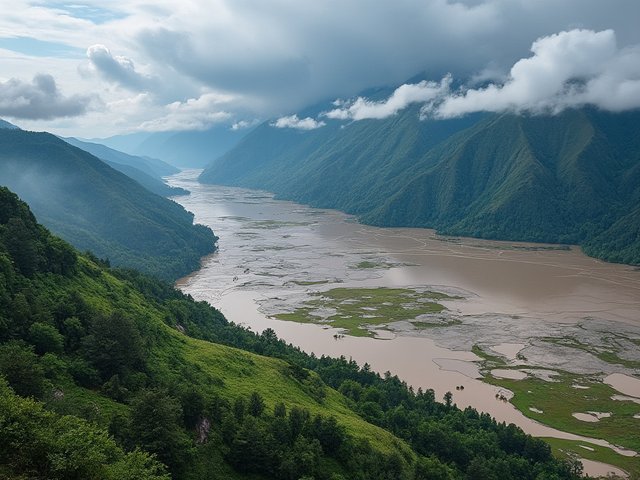🌧️ Major South Asian Nations Flooded: Is It Really Nature’s Wrath or Human Mismanagement?
🌧️ Major South Asian Nations Flooded: Is It Really Nature’s Wrath or Human Mismanagement?

In the last few months, several South Asian nations have been grappling with devastating floods that have displaced millions, destroyed infrastructure, and claimed numerous lives. Nations like India, Pakistan, Bangladesh, and Nepal have been the worst hit. While the monsoon rains are an annual event in this region, the extent and frequency of these floods seem to worsen each year. This begs the question: are these floods a natural disaster, or is it a catastrophe born out of human mismanagement?
🌊 Flooding: A Natural Phenomenon with Man-Made Consequences
Flooding, in its essence, is a natural process. It happens when rivers overflow due to excessive rain, melting snow, or obstructions in their path. In areas where human interference is minimal, floods can actually play a vital role in sustaining ecosystems—replenishing groundwater, supporting agriculture, and nurturing biodiversity. But when floods impact human settlements, we begin to label them as "disasters."
The Real Culprit: Human Encroachment on River Spaces
One of the most pressing issues in South Asia is human encroachment into riverbeds and floodplains. In a rush to expand cities and infrastructure, rivers have been boxed in, and their natural flow paths have been restricted. We have built roads, settlements, and industrial areas right into the space that rivers naturally occupy during heavy rains. When the monsoon rains come, these rivers—deprived of their natural floodplains—have no space to expand, causing devastating floods that wash away everything in their path.
Urbanization: In major cities like Mumbai (India) and Karachi (Pakistan), unchecked urbanization has meant that rivers have been encroached upon or diverted to make way for roads and buildings. Rivers like the Mithi River in Mumbai and the Lyari River in Karachi have been drastically narrowed due to illegal construction.
Agricultural Expansion: Rivers in rural areas, too, are being claimed for farming. Floodplains, which once absorbed excess rainwater, are now turned into crop fields, leaving rivers with no buffer when the rains come.
Blocking the River's Flow: Dams and Barrages
While dams and barrages are constructed for flood control, power generation, and irrigation, they often cause more harm than good when it comes to flood management. South Asia is crisscrossed with major river systems like the Ganges, Indus, and Brahmaputra, all of which have been subjected to extensive damming.
Impact of Dams: These dams often trap sediment that would otherwise flow downstream, causing rivers to rise higher and flood more easily. Furthermore, in times of extreme rainfall, these dams have to release water, adding to the flooding downstream.
Silt Buildup: The barrages and embankments created to channel the river often cause silt to build up over time, raising the riverbed. When monsoon rains come, the water breaches these embankments, flooding nearby areas.
🛣️ Roads and Infrastructure Taking Over River Paths
Infrastructure development is often hailed as a sign of progress, but when it comes at the expense of natural watercourses, it’s a recipe for disaster.
Roads and Railways: In India and Nepal, major highways and railways have been built across floodplains, obstructing the natural flow of rivers and trapping water in areas that were historically flood-free.
Faulty Drainage Systems: In many cities, drainage systems are outdated and ill-equipped to handle the volume of water during the monsoons. Urban areas in Bangladesh, such as Dhaka, frequently flood due to clogged or inefficient drainage.
🌱 Environmental Mismanagement: Deforestation and Soil Erosion
The destruction of forests in South Asia has made the region even more vulnerable to flooding. Forests act as natural sponges, absorbing water and reducing the amount of runoff that ends up in rivers.
Deforestation: Countries like Nepal and India have seen rapid deforestation due to urban expansion, agriculture, and illegal logging. As a result, soil erosion has increased, causing rivers to fill with silt and reducing their capacity to carry water.
Soil Erosion: With less tree cover to hold the soil, heavy rains wash the soil into rivers, raising their beds and causing them to overflow. This is particularly evident in the mountainous regions of Nepal and northern India, where landslides triggered by deforestation are frequent during the rainy season.
💡 Human Error: Poor Urban Planning and Lack of Disaster Preparedness
Another reason why floods turn into disasters is poor urban planning and the lack of effective disaster preparedness. Governments often fail to invest in flood mitigation infrastructure or to enforce zoning laws that prevent construction on floodplains.
Unregulated Construction: Many areas in India, Bangladesh, and Pakistan see unregulated construction, especially in flood-prone zones. Buildings, roads, and bridges are often constructed without proper flood defenses, leading to massive destruction when floods occur.
Lack of Early Warning Systems: While some South Asian countries have made strides in improving early warning systems, many rural and urban communities are still left in the dark when floods are imminent. This lack of preparedness exacerbates the damage.
🌍 Conclusion: Nature Isn't the Enemy—We Are
Floods will always happen. It's a natural part of life for any region with rivers and rainfall. However, what turns these floods into disasters is the way we, as humans, have chosen to interact with our environment. By encroaching on river spaces, cutting down forests, and failing to plan our cities with the climate in mind, we have made ourselves vulnerable to these so-called “natural disasters.”
If we want to prevent future catastrophes, we must rethink our approach to urban planning, infrastructure development, and environmental protection. Rivers need space, forests need to be preserved, and we need to recognize that the solution lies not in battling nature but in working with it.
Sources:
- Research from various environmental studies on urban encroachment and river systems.
- Case studies from flood-prone regions in India, Bangladesh, Nepal, and Pakistan.
- Data from disaster management authorities in South Asia.